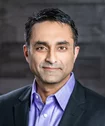From acquisition to innovation: How Microsoft is advancing diagnostic imaging
It’s been two and a half years since Microsoft completed its acquisition of Nuance Communications for a reported $19.7 billion. At the time of the March 2022 transaction, Microsoft said it liked Nuance for its core strengths—AI-powered voice recognition and related software and services—across numerous industries.
However, as one executive remarks, one sector of the economy is especially close to Microsoft’s heart: healthcare.
“I worked in multiple industries before joining Nuance” in April of 2021, says the executive, Vikram Chhabra, MBA, MS, before giving away the source of his friendly bias. “When I got here and took on healthcare, I found a home. That sense has only grown over the time I’ve worked for Microsoft.”
Today Chhabra is general manager of diagnostics products in Microsoft’s health and life sciences division in Burlington, Mass. His past roles include progressively responsible leadership positions with IBM and Cisco.
Chhabra took questions from Radiology Business on everything from the original spark of the Microsoft-Nuance relationship to the dangers of fast global expansion to the escalating criticality of cybersecurity in healthcare.
Underlying the conversation was a broad but pointed theme: How is healthcare better served now—by one Microsoft—than it was before?
Healthcare AI on a massive scale
Looking back now, tuned-in healthcare watchers might agree that the acquisition seemed inevitable. For quite some time before Nuance became part of Microsoft, Chhabra points out, both companies shared a vision of using AI to mitigate clinician burnout and enhance patient care. On top of that, Nuance had long used Microsoft Azure as its cloud computing platform.
As high-level talks around joining forces progressed, a clear consensus emerged, Chhabra recalls.
“We could see that both companies’ client rosters would benefit by a melding of our technologies into a common stack,” he explains. A key part of this process would be “unlocking data from individual applications and departmental silos. This would let our hospitals and other provider organizations leverage AI on a truly vast scale.”
It also helped that the respective corporate cultures were similar enough that “really anyone could have seen we’d be a pretty natural fit for each other,” Chhabra says.
For some employees, it was even cozier than that. As it happened, Nuance and Microsoft shared a parking lot in Burlington. “My commute didn’t change,” Chhabra chuckles. “The only difference is that I used to turn right when I pulled into the lot and now, I turn left.”
Praise for the platform approach
In Chhabra’s mind, Microsoft has advanced its goal of shaping a healthier future with data and AI. Asked for an example, he mentions PowerScribe, the widely used, AI-powered and voice enabled radiology reporting platform, and Dragon and DAX Copilot, conversational and ambient speech solutions for clinical documentation and workflow optimization.
“Microsoft is a platform company, and they’ve been helping us build a dynamic data ecosystem with our [mature and evolving] product lines,” Chhabra says. “We now have the team and infrastructure in place to make this healthcare platform vision a reality.”
In practical terms this means their products are part of Microsoft Cloud for Healthcare, a comprehensive suite of industry-specific cloud, data and AI solutions. The expansion lets Microsoft partners and customers build and scale clinical AI applications.
And as Chhabra sees it: “We believe this open and integrated platform approach will broaden the AI ecosystem and introduce our customers to new opportunities and innovations. That’s huge.”
What’s more, he’s quick to add, the cloud compute and global scale of Azure makes the benefits of both new and existing solutions accessible to more healthcare organizations around the world.
Yet concern remains that rapid global market expansion will make it more difficult to manage AI challenges such as healthcare inequities, model hallucinations, training data quality and security.
“Those challenges are real. But honestly, the timing couldn’t be better to get in front of the potential pitfalls inherent in AI,” Chhabra offers with unabashed enthusiasm. “Microsoft has been very vocal in driving standards for responsible AI. Before any product goes to market, we must go through our Responsible AI Board, which ensures we are developing and deploying AI safely. It’s all about fostering innovation while reducing risk.”
Cybersecurity investment as a business decision
Arguably the biggest single challenge for healthcare providers making their way through the Digital Age is especially near and dear to Chhabra. That would be cybersecurity.
Chhabra mastered the art, science and oversight of the discipline, largely while at Cisco (2001 to 2017) and IBM (2017 to 2021). Even so, he remains humbled enough by the scope and persistence of the threat to admit that the learning curve never flatlines.
“The frontier of large language models is very new and very attractive to bad actors,” he says.
The good news, he suggests, is that Microsoft is as methodical and nimble a force as there is in the war between the good guys and the cybercriminals. And its sheer size can be an advantage.
That’s important since financial damages caused by organized gangs and other malicious hackers are projected to top $10.5 trillion by next year, making cybercrime the third largest source of economic impact in the world after the U.S. and China, Chhabra notes, citing a 2024 report from Cybersecurity Ventures.
At Microsoft, he says, investing in cybersecurity is a business decision and a CEO-level mandate. As part of the company’s Secure Future Initiative, structured updates go out to all Microsoft entities every quarter, month and sprint—which is a period in which a discrete team works to complete a project or set of deliverables.
“It’s all about keeping up with a threat landscape that’s always changing,” Chhabra says. “You’re always trying to ‘up’ your defenses because the bad guys are always trying to break through them.”
The battle is probably never ending, he says, because human nature ensures someone will always be trying to hack into a network, hold a hospital hostage for ransom or cause another newsworthy data breach.
“If you ever think you’ve invested enough in security and that’s it, you’re wrong,” Chhabra warns. “You need to have a threat protection strategy, monitoring strategy, response strategy, recovery strategy. You must be holistic in your preparation—not just with your legacy applications but with every point at which a breach might be possible.”
At Microsoft, he underscores, cybersecurity is a core investment. “I don’t see that changing.”

‘We are on a mission. There’s always another way to harness a platform approach to tackle the problems and opportunities our customers have in front of them.’
Vikram Chhabra, general manager of diagnostics products in Microsoft’s health and life sciences division
Burnout in the crosshairs
Microsoft Healthcare remains focused on using AI to alleviate clinician burnout. This is a special concern in radiology, he says, where a shortage of radiologists is compounding the challenge of meeting the growing needs of an aging population and more imaging data than ever. AI helps not only by increasing the efficiency of radiology reporting but also by delivering clinical guidance, organizing radiologists’ worklists by priority or subspeciality, flagging laterality, sex and other errors, and automating tedious administrative tasks.
“We are on a mission,” Chhabra says. “When you’re obsessed with leveraging technology to improve not just efficiencies but also clinicians’ quality of life—as we are—you’re in a steady state of excitement. There’s always another way to harness a platform approach to tackle the problems and opportunities our customers have in front of them.”
Speaking of customers, it’s not unusual for Chhabra to go onsite to visit radiology reading rooms, to see and hear firsthand what Microsoft can do to further empower radiology teams.
“When I sit down with a radiologist and they tell me our AI products and services help them finish up early, allowing them to go spend time with their family, that makes my day,” he says. “It reinforces for me that I made the right move when I started specializing in healthcare.”
And at times like those, Chhabra shares, the physician feedback affirms his belief that Microsoft can do more for healthcare than ever before.
Learn more about Microsoft diagnostic solutions.

